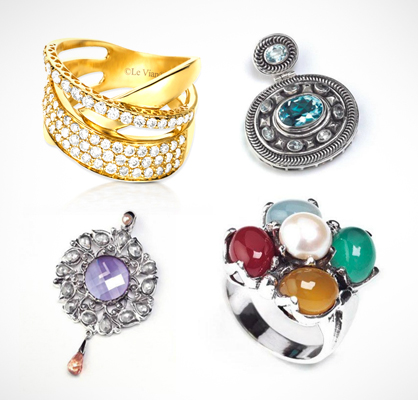Jewelry’s new trends to boost sales
As shoppers hunt for bargains, jewelry companies are turning to colored diamonds, fun statement jewelry embedded with semiprecious gems and animal-inspired accessories in an effort to entice economically prudent customers, reported WWD.
“We believe the consumer is much more value-driven. When they buy something, they want to make sure there’s a high intrinsic value,” Eddie LeVian, designer and CEO of family-owned jewelry firm LeVian Corp., said to WWD. “In the past, jewelry has not been seen as a fashion item.”
His company caters to a wide array of price points, from a few hundred dollars to high-end couture jewelry that commands a few million. But even this range has not proven enough in today’s economy. LeVian has been forced to go back to the drawing board and rework his jewelry designs, as well as turning to natural brown diamonds as natural-colored diamonds become harder to obtain.
“We are democratizing the jewelry industry,” LeVian told WWD. “Brown diamonds are about one quarter of the price of natural diamonds.”
More than ever, it is crucial to pinpoint emerging trends. LeVian finds inspiration from Pantone color palette and by watching what celebrities are sporting around town. One recent vogue item is what LeVian terms “super gladiator jewelry,” which capitalizes on the famed gladiator sandal by featuring a latticework of diamonds and gold.
Other cost-cutting strategies include using more colored gems and adding silver to gold items. “We definitely had to change our styling. The customer is very price-conscious,” president of Emsaru Jewels Corp. Atul Dangayach said.
The savings add up fast. The shopper who chooses to use colored gems, more silver, and other types of diamonds can slice 30 to 50 percent off a piece’s price.
This new inclination of using colored stones is not just thrifty, but is also in style. Sales have been driven in part by Prince William’s decision to present Catherine Middleton with his mother’s sapphire engagement ring.
“Bold colors are driving fashion trends in jewelry,” Dangayach said.
He continues: “Consumers are coming back to buy, but it’s a gradual jump. What’s challenging for us is creating beautiful jewelry at the right price point.”
The question becomes how to craft weightier, bold statement jewelry while keeping prices affordable, claims Sofia Eleftheriou, design director at Kabana, an Albuquerque, N.M.-based jeweler.
“Now we have to use less gold, but we don’t want to hollow out the back [of the jewelry] and lose the quality we’ve established,” she said.
So instead of filling the back with gold as was its previous tradition, the company has decided to add a “lattice of gold.”
But the economic trends do not necessarily mean that consumers are stepping back. While Eleftheriou refers to the new customer as “more deliberate,” Greg Der Calousdian, vice president of Vahan Jewelry, believes that what shoppers want is to stretch their dollar.
“People have got cabin fever and we’re prepared for that,” he said. Vahan has introduced a new “aspirational” collection priced between $750 and $1,300, in contrast to its core collection, offered for $1,200 to $3,000.
Indian jewelry brand Amrapali also is on board with providing an assortment of prices: Its new elephant-themed collection comes in anywhere from $500 to $50,000. You can opt for the level that meets your needs: The lowest priced level combines silver and gold, the second level includes more gold and the top two add diamonds of various sizes and quantities.
Now the shopper who “cannot afford the $30,000 piece” will be able to “obtain a similar piece at $3,000,” head designer Tarang Arora said.
All these trends add up: At the upcoming JCK trade show in Las Vegas, value will be the word of the day, with accessories that reinvigorate and supplement the clothes consumers already own.
Tagged in: jewelry, sales, vahan, kabana, levian, emsaru, amrapali,

Purple Neon/LadyLUX



